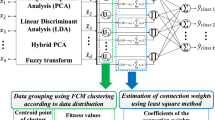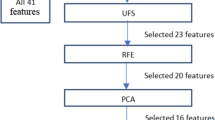Abstract
In this paper a novel automatic method to identify digital communication signals is presented for different signal to noise ranges (SNRs). The method is based on the idea of optimization of the adaptive neuro-fuzzy inference system (ANFIS) including three major modules: the feature extraction the classification and optimization module. In the feature extraction module, an effective combination of the higher order moments (up to eighth), higher order cumulants (up to eighth) and spectral characteristics are proposed as the efficient features. For classification of the extracted features, ANFIS is investigated as a powerful classifier. In the training of ANFIS, the vector of radius has very important roles for its recognition accuracy. Therefore, in the optimization module, cuckoo optimization algorithm (COA) is proposed for optimization of the classifier to find the optimum value of radius. Experimental results clearly indicate that the proposed hybrid intelligent method has a high classification accuracy to discriminate different types of digital signals even at very low SNRs.





Similar content being viewed by others
References
Sue, W., Jefferson, L. X., & Mengchou, Z. (2008). Real-time modulation classification based on maximum likelihood. IEEE Communications Letters, 12, 781–784.
Yang, Y., Chang, J.-N., Liu, J.-C., & Liu, C.-H. (2004). Maximum loglikelihood function-based QAM signal classification over fading channels. Wireless Personal Communications, 28, 77.
Wei, W., & Mendel, J. M. (2000). Maximum-likelihood classification for digital amplitude-phase modulations. IEEE Transactions on Communications, 48(2), 189–193.
Wu, H. C., Saquib, M., & Yun, Z. (2008). Novel automatic modulation classification using cumulant features for communications via multipath channels. IEEE Transactions on Wireless Communications, 7(8), 3098–3105.
Wong, M. L. D., & Nandi, A. K. (2004). Automatic digital modulation recognition using artificial neural network and genetic algorithm. Signal Processing, 84, 351–365.
Hassan K., Dayoub I., Hammouda W., Berbineau M. (2009) Automatic modulation recognition using wavelet transform and neural network, in: Proceedings of IEEE Conference on Intelligent Transport Systems Telecommunications (pp. 234–238).
Mobasseri, B. G. (2000). Digital modulation classification using constellation shape. Signal Processing, 80, 251–277.
Deng, H., Doroslovacki, M., Mustafa, H., Jinghao, X., & Sunggy, K. (2002). Automatic digital modulation classification using instantaneous features. Proceedings ICASSP, 4, IV4168.
Azarbad, M. Hakimi, S. Ebrahimzadeh, A. (2012). Automatic recognition of digital communication signal. International Journal of Energy, Information and Communications, 3(4), 21–34.
Avci, E., Hanbay, D., & Varol, A. (2007). An expert discrete wavelet adaptive network based fuzzy inference system for digital modulation recognition. Expert Systems with Applications, 33, 582–589.
HU, Y., Liu, J., & Tan, X. (2010). Digital modulation recognition based on instantaneous information. The Journal of China Universities of Posts and Telecommunications, 17(3), 52–59.
Swami, A., & Sadler, B. M. (2000). Hierarchical digital modulation classification using cumulants. IEEE Transactions on Communications, 48, 416–429.
Lopatka J., and Macrej P. (2000), Automatic modulation classification using statistical moments and a fuzzy classifier, in Proceedings of the 5th International Conference on Signal Processing (ICSP ’00), vol. 3, pp. 1500–1506, Beijing, China.
Liu, A., & ZHU, Q. (2011). Automatic modulation classification based on the combination of clustering and neural network. The Journal of China Universities of Posts and Telecommunications, 18(4), 13–19.
Zhou, X., Wu, Y., & Wang, D. (2011). Application of kernel methods in signals modulation classification. The Journal of China Universities of Posts and Telecommunications, 18(1), 84–90.
Hagedorn, G., James, B., & Miller, C. (1997). Neural network recognition of signal modulation types, Proc. ANNIEC (pp. 170–175).
Nandi, A. K., & Azzouz, E. E. (1998). Algorithms for automatic modulation recognition of communication signals. IEEE Transactions on Communications, 46(4), 431–436.
Zhao, Y., Ren, G., Wang, X., Wu, Z., & Gu. (2003). Automatic digital modulation recognition using artificial neural networks, Proc. ICNNSP (pp. 257–260).
Ebrahimzadeh, A., Azimi, H., & Mirbozorgi, S. A. (2011). Digital communication signals identification using an efficient recognizer. Measurement, 44, 1475–1481.
Jain, A. K., & Dubes, R. C. (1988). Algorithms for clustering data. NJ: Englewood Cliffs.
Mobasseri, B. G. (2000). Digital modulation classification using constellation shape. Signal Processing, 80(2), 251–277.
Azarbad M., Ebrahimzade A., Yousefi M. (2011). “Comparison of clustering algorithms for recognition of radio communication signals based on the HOS”, Proceedings of the IASTED International Conference, Signal Processing, Pattern Recognition, and Applications (SPPRA 2011), 10.2316/P.2011.721-009
Ebrahimzade, S. A. (2012). A novel method for automatic modulation recognition. Applied Soft Computing, 12, 453–461.
Ebrahimzadeh, A., & Ghazalian, R. (2011). Blind digital modulation classification in software radio using the optimized classifier and feature subset selection. Engineering Applications of Artificial Intelligence, 24, 50–59.
Kennedy J., Eberhart R. C., and Shi Y. (2001) Swarm Intelligence (Morgan Kaufmann Publishers).
Jang, J. S.R., Sun, C.T. Mizutani, E. (1997): Neuro-fuzzy and soft Jondral. (Prentice Hall).
Sugeno, M., & Kang, G. T. (1988). Structure identification of fuzzy model. Fuzzy Sets and Systems, 28, 15–33.
Takagi, T., & Sugeno, M. (1985). Fuzzy identification of systems and its applications to modeling and control. IEEE Transactions on Systems Man and Cybernetics, 15, 116–132.
Takagi T., Sugeno M. (1985). Derivation of fuzzy control rules from humanoperator’s control actions, in: Proc. IFAC Symp. Fuzzy Inform.,Knowledge Representation and Decision Analysis, 55–60.
Mamdani, E. H., & Assilian, S. (1975). An experiment in linguistic synthesis with afuzzy logic controller. International Journal of Man-Machine Studies, 7, 1–13.
Jang, J. S. R. (1993). ANFIS: Adaptive-Network-based Fuzzy Inference Systems, IEEE Trans. Systems, Man, and Cybernetics, 23(3), 665–685.
Haykin, S. (2003). Neural networks—a comprehensive foundation (2nd ed.). New Delhi: Prentice-Hall of India Pvt. Ltd.
Zurada J.M. (1992) Introduction to Artificial Neural Systems, PWS Publication Company.
Hagan, M. T., Demuth, H. B., & Beale, M. H. (1996). Neural network design. Boston: PWS Publishing.
Chiu, S. (1994). Fuzzy model identification based on cluster estimation. Journal of Intelligent & Fuzzy Systems, 2(3), 267–278.
Chiu, S. (1996). Selecting input variables for fuzzy models. Journal of Intelligent & Fuzzy Systems, 4(4), 243–256.
Buragohain, M., & Mahanta, C. (2008). A novel approach for ANFIS modelling based on full factorial design. Applied Soft Computing, 8, 609–625.
Rajabioun, R. (2011). Cuckoo optimization algorithm. Applied Soft Computing, 11, 5508–5518.
Hosoz, M., Ertunc, H. M., & Bulgurcu, H. (2011). An adaptive neuro-fuzzy inference system model for predicting the performance of a refrigeration system with a cooling tower. Expert Systems with Applications, 38, 14148–14155.
Keles, A., Keles, A., & Yavuz, U. (2011). Expert system based on neuro-fuzzy rules for diagnosis breast cancer. Expert Systems with Applications, 38, 5719–5726.
Author information
Authors and Affiliations
Corresponding author
Rights and permissions
About this article
Cite this article
Azarbad, M., Ebrahimzadeh, A. & Addeh, J. A New Intelligent Approach for Recognition of Digital Satellite Signals. J Sign Process Syst 79, 75–88 (2015). https://doi.org/10.1007/s11265-013-0829-0
Received:
Revised:
Accepted:
Published:
Issue Date:
DOI: https://doi.org/10.1007/s11265-013-0829-0




